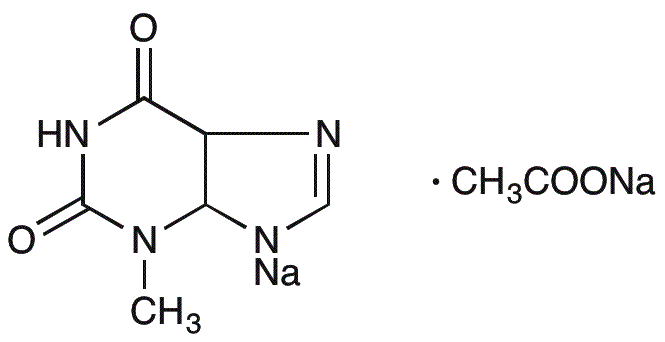Theophyllol is widely utilized in research focused on:
- Pharmaceutical Development: It serves as a key ingredient in medications for respiratory conditions, helping to relax bronchial muscles and improve airflow in patients with asthma or COPD.
- Food and Beverage Industry: Used as a flavoring agent and stimulant in various products, it enhances the taste and provides a mild energy boost, similar to caffeine.
- Agricultural Applications: Theophyllol can be used in certain herbicides, offering a natural alternative for weed control while minimizing environmental impact.
- Research and Analytical Chemistry: It is employed in laboratories for studying purine metabolism and its effects on human health, providing insights into various biochemical pathways.
- Cosmetic Formulations: The compound is incorporated into skincare products for its antioxidant properties, helping to protect the skin from oxidative stress and improve overall skin health.
General Information
Properties
Safety and Regulations
Applications
Theophyllol is widely utilized in research focused on:
- Pharmaceutical Development: It serves as a key ingredient in medications for respiratory conditions, helping to relax bronchial muscles and improve airflow in patients with asthma or COPD.
- Food and Beverage Industry: Used as a flavoring agent and stimulant in various products, it enhances the taste and provides a mild energy boost, similar to caffeine.
- Agricultural Applications: Theophyllol can be used in certain herbicides, offering a natural alternative for weed control while minimizing environmental impact.
- Research and Analytical Chemistry: It is employed in laboratories for studying purine metabolism and its effects on human health, providing insights into various biochemical pathways.
- Cosmetic Formulations: The compound is incorporated into skincare products for its antioxidant properties, helping to protect the skin from oxidative stress and improve overall skin health.
Documents
Safety Data Sheets (SDS)
The SDS provides comprehensive safety information on handling, storage, and disposal of the product.
Product Specification (PS)
The PS provides a comprehensive breakdown of the product’s properties, including chemical composition, physical state, purity, and storage requirements. It also details acceptable quality ranges and the product's intended applications.
Certificates of Analysis (COA)
Search for Certificates of Analysis (COA) by entering the products Lot Number. Lot and Batch Numbers can be found on a product’s label following the words ‘Lot’ or ‘Batch’.
*Catalog Number
*Lot Number
Certificates Of Origin (COO)
This COO confirms the country where the product was manufactured, and also details the materials and components used in it and whether it is derived from natural, synthetic, or other specific sources. This certificate may be required for customs, trade, and regulatory compliance.
*Catalog Number
*Lot Number
Safety Data Sheets (SDS)
The SDS provides comprehensive safety information on handling, storage, and disposal of the product.
DownloadProduct Specification (PS)
The PS provides a comprehensive breakdown of the product’s properties, including chemical composition, physical state, purity, and storage requirements. It also details acceptable quality ranges and the product's intended applications.
DownloadCertificates of Analysis (COA)
Search for Certificates of Analysis (COA) by entering the products Lot Number. Lot and Batch Numbers can be found on a product’s label following the words ‘Lot’ or ‘Batch’.
*Catalog Number
*Lot Number
Certificates Of Origin (COO)
This COO confirms the country where the product was manufactured, and also details the materials and components used in it and whether it is derived from natural, synthetic, or other specific sources. This certificate may be required for customs, trade, and regulatory compliance.


